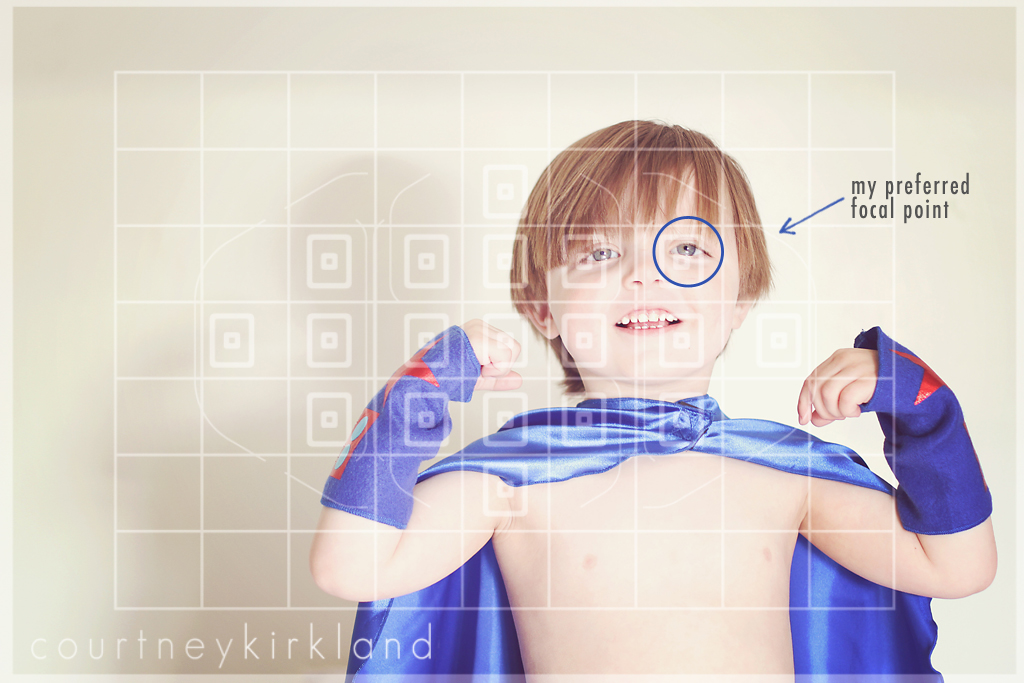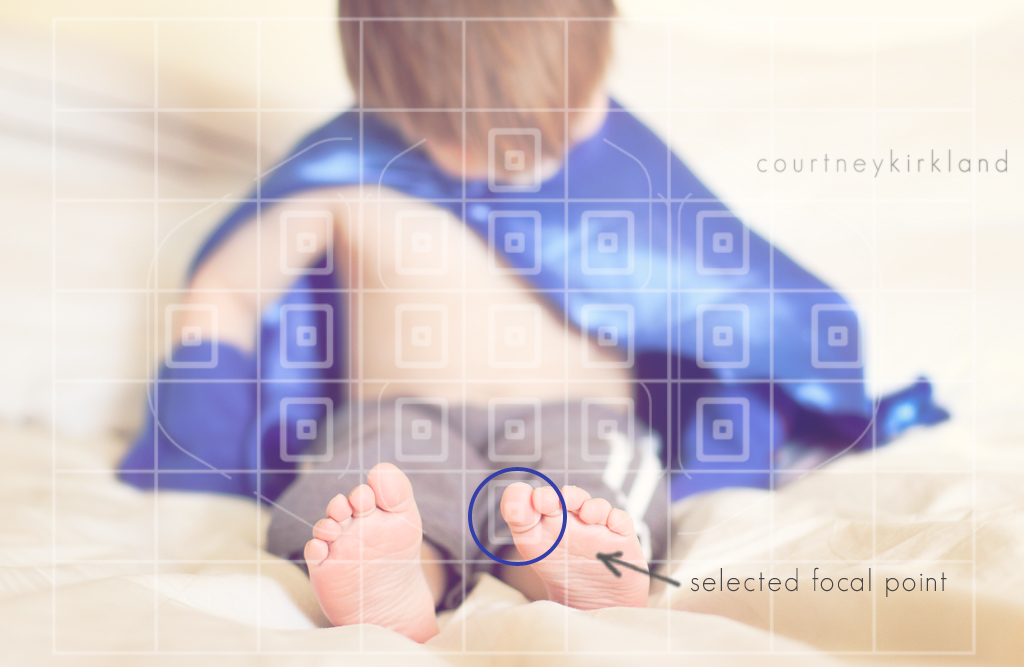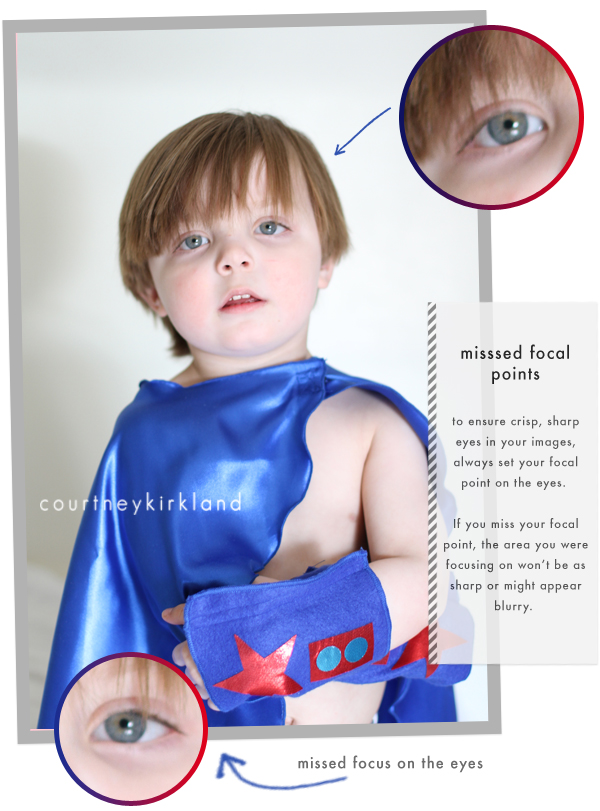I'm a mama of three doing what I love and fueled by Grace, Mercy, and a whole lot of coffee. I'm so glad you are here!
Hey, friend!
I'm Courtney.
mini brand
brand building
website design
template customization
tell me more
Browse by
category
Move to Manual: Understanding Focal Points
We are slowly winding down this series on understanding your camera a bit better and making that jump from Auto to Manual. I really appreciate all of the feedback that you guys have given and I hope that you are all enjoying this series as much as I’ve enjoyed putting it together. To view all of the posts in this series, be sure to check out the Move to Manual Button in the sidebar.
Over the last several weeks, I’ve received emails and comments from many of you who are loving the series but still feel like your photos aren’t quite where you want them to be. I’ve spent a while browsing through the Flickr Pool and visiting your blogs, and one thing that I noticed in several photos is that some of you are missing your Focal Points. The composition is good, the lighting is good, but the key areas of your image are slightly blurry. I know how frustrating this can be and it can ruin the look of an entire picture. So today, we’re going to learn to resolve that. The key to solving this issue lies with your Focal Points.
Pick up your camera and turn it on. Look through the eyepiece and set up like you are going to take a shot. Do you see those little dots within your viewfinder? Those are your Auto Focus Points.
Here’s an image of what they might look like depending on what type of camera you have. The one on the left is a Nikon, the one on the right is a Canon.
|| Source ||
I’ve already talked about using the rule of thirds and overcoming the desire to shoot with your subject in the center of the photograph all the time. But, being armed with that secret and tip for better composition won’t do you any good if your focal point is off. Most cameras are set to focus in the center by default. When you open your camera up for the first time, unless you change that setting, your camera is going to focus on the center point in your image. But there is a way that you can tell your camera where to focus.
On my Canon 7D (and I’m going to assume on all SLR cameras) if you shoot in Auto or Program mode, you have no control over where you camera focuses. Your camera is going to choose a focal point for you (which is all the more reason for you to leave Auto Mode behind!). Since you’re shooting in manual now (and I hope that most of you are!), it’s time for you to be the boss and tell your camera where it is that you want to focus your shot.
First things first, you’ll need to make sure that you camera is set to Auto Focus and not to Manual Focus. For information on how to do this (as well as how to change the settings that we will be discussing in this post) please refer to your Camera’s User Manual!
There are three different types of Auto Focus Modes: One Shot, Al Servo and Al Focus.
One Shot (Canon)/AF-S: Auto Focus-Single (Nikon)
One Shot Focus/AF-S is used for subjects that are being perfectly still and won’t be moving in any way. Buildings, plants, etc. Something that you know isn’t going to wiggle or even breath heavy while you are composing your shot and getting ready to snap your image.
Al Servo (Canon)/AF-C: Auto Focus-Continuous (Nikon)
This is typically what my camera stays on. Al Servo Focus/AF-C is for shooting an object that might move…like a wiggly and rambunctious three year old boy. I highly recommend that if you are going to be shooting children, babies, or even flowers that might blow in the breeze, that you consider setting your camera to Al Servo Mode. It offers a bit more security in making sure that your shot is in focus when your subject might move.
Al Focus (Canon)/AF-A: Auto Focus-Automatic(Nikon)
This is the in between auto focus mode. Al Focus/AF-A will automatically switch your camera from One Shot/AF-S (when you have a stationary subject) to Al Servo/AF-C (a moving subject) if the subject moves any. I’ve never used this mode because I primarily shoot people, but if you do a lot of landscape or architectural shooting, this might be something for you to check out if you want that option.
Now that you’ve changed up your camera settings and chosen the Auto Focus mode that suits you best, let’s talk about the actual selection of a Focal Point. Again, you’ll need to refer to your cameras manual for how to do this on your camera since each make and model is a bit different.
Choosing a Focal Point
It’s a known rule that when you shooting images of people, you want the eyes to be the sharpest and clearest point in your image. That’s why you should always set your focal point on the eye of your subject. And I’m sure you’re now asking Which eye should I focus on? I have always heard (from other photographers and the various photography communities that I belong to) that you want to place your focal point on the eye that is closest to your lens. If your aperture is set properly, you should be able to focus on the eye closest to you and still get the other eye in focus as well.
As you can see in the image below, I chose Noah’s right eye as my focal point. Since I am right handed, I typically line my images up to the right (a habit I’m working on). That right corner tends to be my preferred focal point, depending on if I’m shooting horizontally or vertically.
I don’t always focus on the eyes, though. Sometimes, when I’m going for more creative shots, I use different areas to focus on. For instance, in the photo below, I was going for a shot of just Little Man’s tiny feet. I set my focal point to his big toe and used a wider f/stop (a lower number) to active the bokeh in the background.
What happens if I miss my focal point?
Sometimes, especially when shooting children, you can miss your focal point. This happens to me sometimes, typically when I’m shooting with an aperture lower than 2.2 or so. When you use an aperture that wide, you have less of a focal plane and even the slightest movement can cause the image to blur. Take a look at the image below. At first glance, from farther away, it looks okay. But, if you zoom in on the eyes, you’ll see that I missed the focal point by just an inch or so. Instead of focusing on his eyes, I ended up focusing on his cheek. He probably wiggled or I moved when I clicked the image and it threw the whole thing off.
To Sum it Up…
Mastering focal points takes a LOT of practice. Especially if you are shooting babies, children or even antsy teenagers. It’s not something that I have mastered yet (nor do I think anyone ever gets it right in every single image). But, the key is to practice. Most cameras have a sweet spot when it comes to focusing. There are some areas that are sharper than others. Spend some time playing with the Auto Focus settings on your camera and see if you can find the spots that are sharpest for your particular camera. Remember, when shooting portraits focus on the eye that is closest to you. If you find that the other eye isn’t as sharp , try opening up your aperture a bit (a higher number) to get it in focus.
For this weeks Flickr Group Assignment, first I want you to find out how many Auto Focus Points your camera has. Then, find a few inanimate objects and try out your focal points. Put one object in the front and the other slightly behind it. Start with a wide aperture (a low number…maybe around 1.8 or 2.0 just to give you some great bokeh) and focus on the object in front. Then the object in back. Now move on your kids or another person (or pet) that moves. PRactice, practice, practice nailing that focal point! Upload your photos to the Group Pool or share them on your blog and come leave the link. I’d love to see how this changes your images!
Leave a Reply Cancel reply
Truly easy-to-customize websites for those who need a polished look with a quick turnaround.
Learn More ↦
Shop premade designs
Draw in potential customers with a seamless web experience and SEO optimized site pages.
Learn More ↦
website design
Discover your creative voice with a unique logo development & coordinating brand collateral.
Learn More ↦
brand building
A seamless single logo brand identity experience for those with a clear vision.
Learn More ↦




Nikon User -D5100- amateur
Great explanation. I just had a photo shoot with my niece on the weekend. I defiantly noticed that her eyes where in focus, but I didn’t understand the focal dots within the eyepiece of the view finder.
Just a clarification the dots on the view finder I want any one of the dots to line up with the eye?
Also When I would switch from one person to two people I found it hard to keep both sharp even when they were close together. Do I switch any settings when I shoot one person then a couple then to group? I did up my aperture.
Yes! The dots you see in your viewfinder are the ones that determine where you are focusing. I recommend determining your aperture by how many people you have. If you have 2 people I’d go with a 3-something aperture, 3 people with a 4-something aperture, etc. Always focus on the eye closest to you and make sure that everyone is within the same focal plane. 🙂
[…] Understanding focal points […]
[…] my method…keep in mind that my camera is always on Al Servo Auto Focus and Partial or Spot Metering Mode. These things are constant and don’t change, so they […]
[…] purchasing via one of the above links and doing so does not add any additional cost to your order. The Canon 100mm f/2.8 USM macro lens focus over the full range from infinity down to life size (1:1…duction ratio). This lens will impress any serious photographer with its combination of versatility, […]
[…] I get all of my other settings fixed in camera, I select my focal point. When I’ve decided which focal point works best for the particular image that I’m […]
Hi Courtney! I’m a budding photographer (still amateur although been practicing for years). I’m just now breaking into the scene and I really enjoy your blog, it’s refreshing to know there are moms like me out there trying to perfect their art…and with SO MUCH to learn, I find I’m constantly RE-learning! Thank you for your info and I look forward to reading your future blogs!
Hey Courtney Im wondering where to place the focal point when shooting 2-4 people? Can you help? Thanks! Nikki Grafton
When I’m shooting more than one person, I generally try to place the focal point on the person who is closest to me. If they are in a straight line (lined up side by side) I go with whoever is in the center. When you shoot more than one person, your aperture should generally be high enough that focusing on the eye specifically won’t matter. I focus on the forehead or the nose of the person instead. 🙂
Courtney,
I have loved this series and I’m hoping you will continue doing stuff like this. These lessons were easy to follow and great practice for me. I am still behind on a couple of them but have tried to keep up. I finally blogged about it on my blog….I’m not a great blogger and don’t have many followers but it’s my space out there that maybe someday I will want to build. For right now, it’s enough for me. Take a look if you’d like and again, thanks so much!!
http://amgstories.blogspot.com/